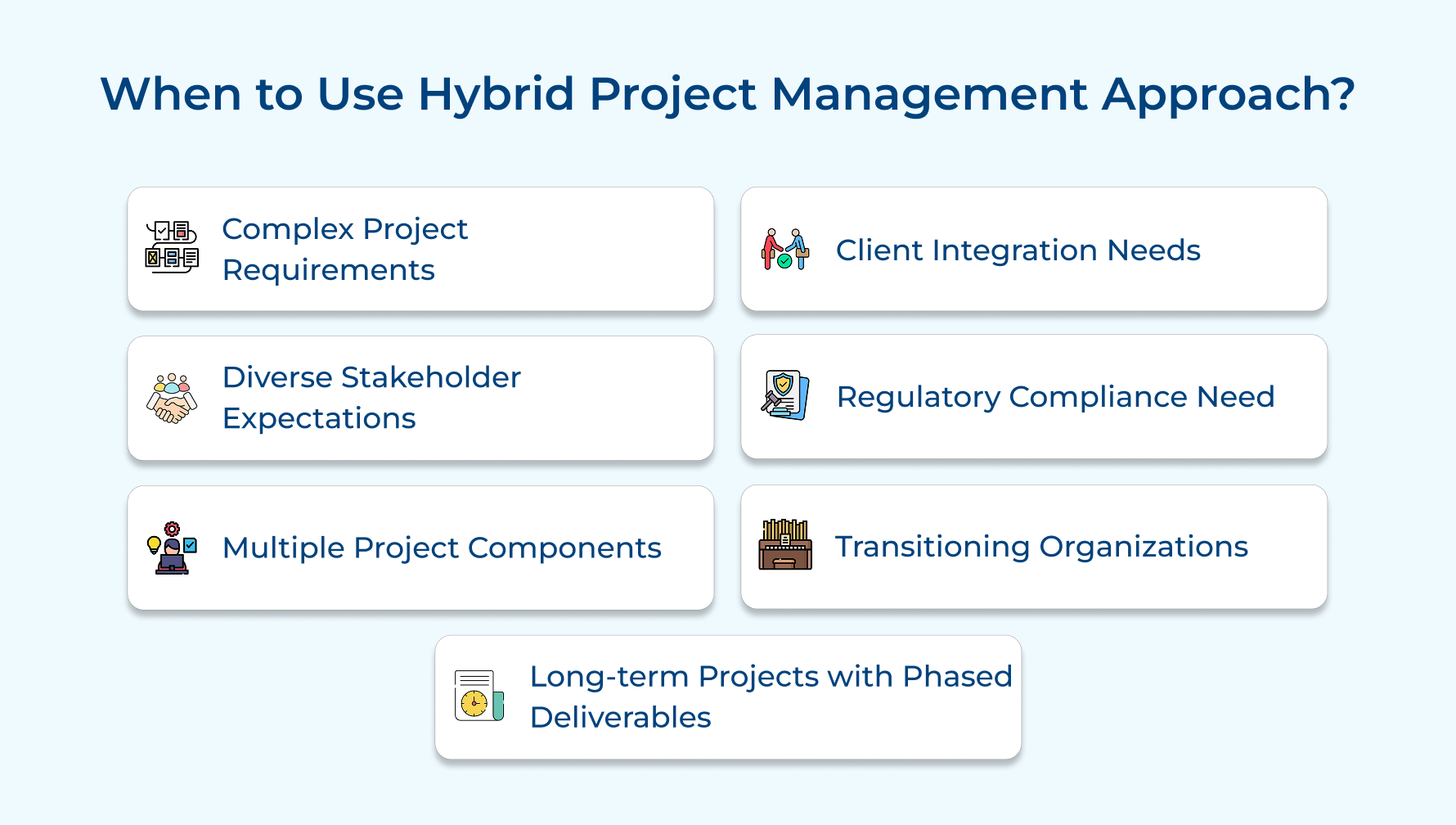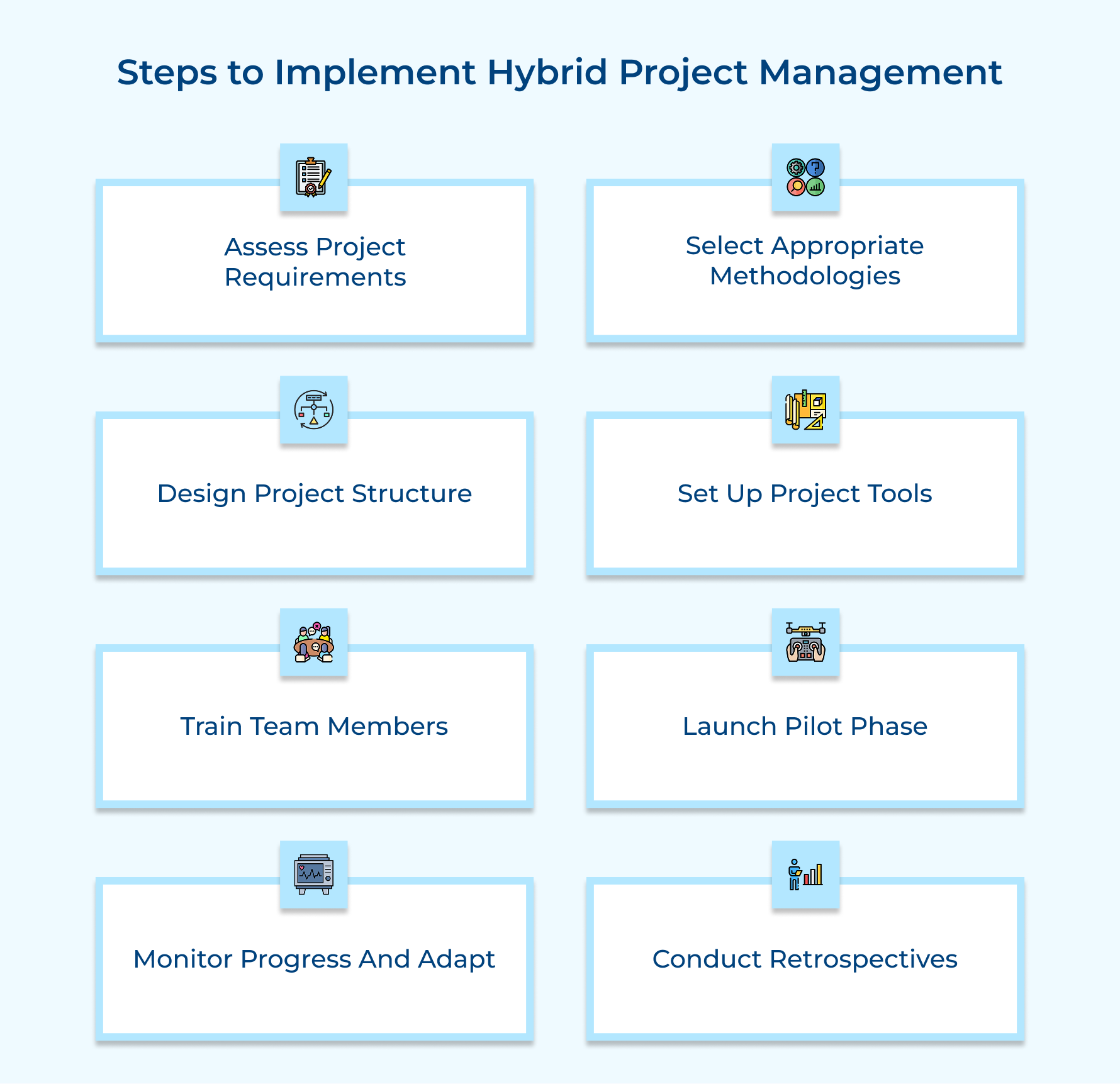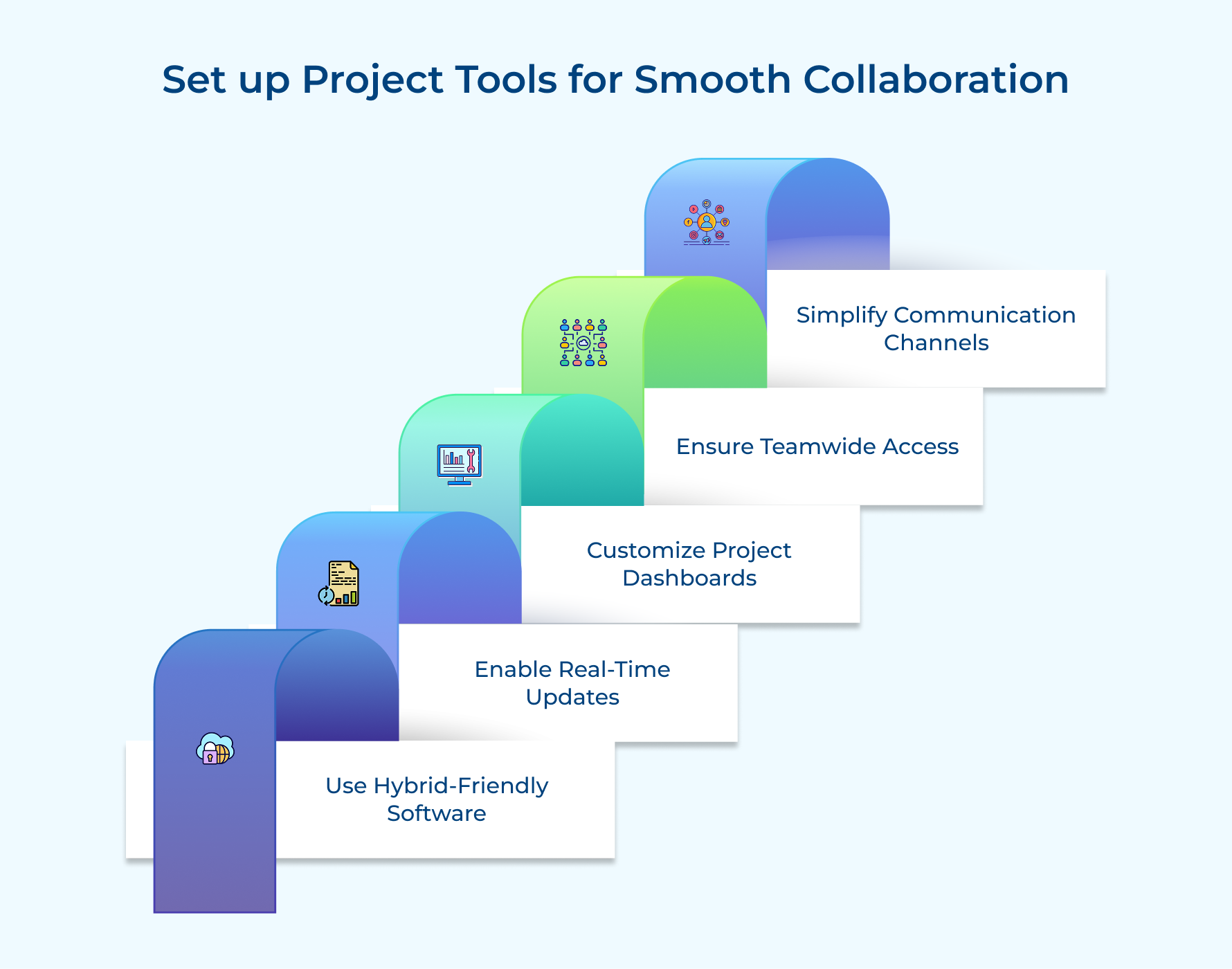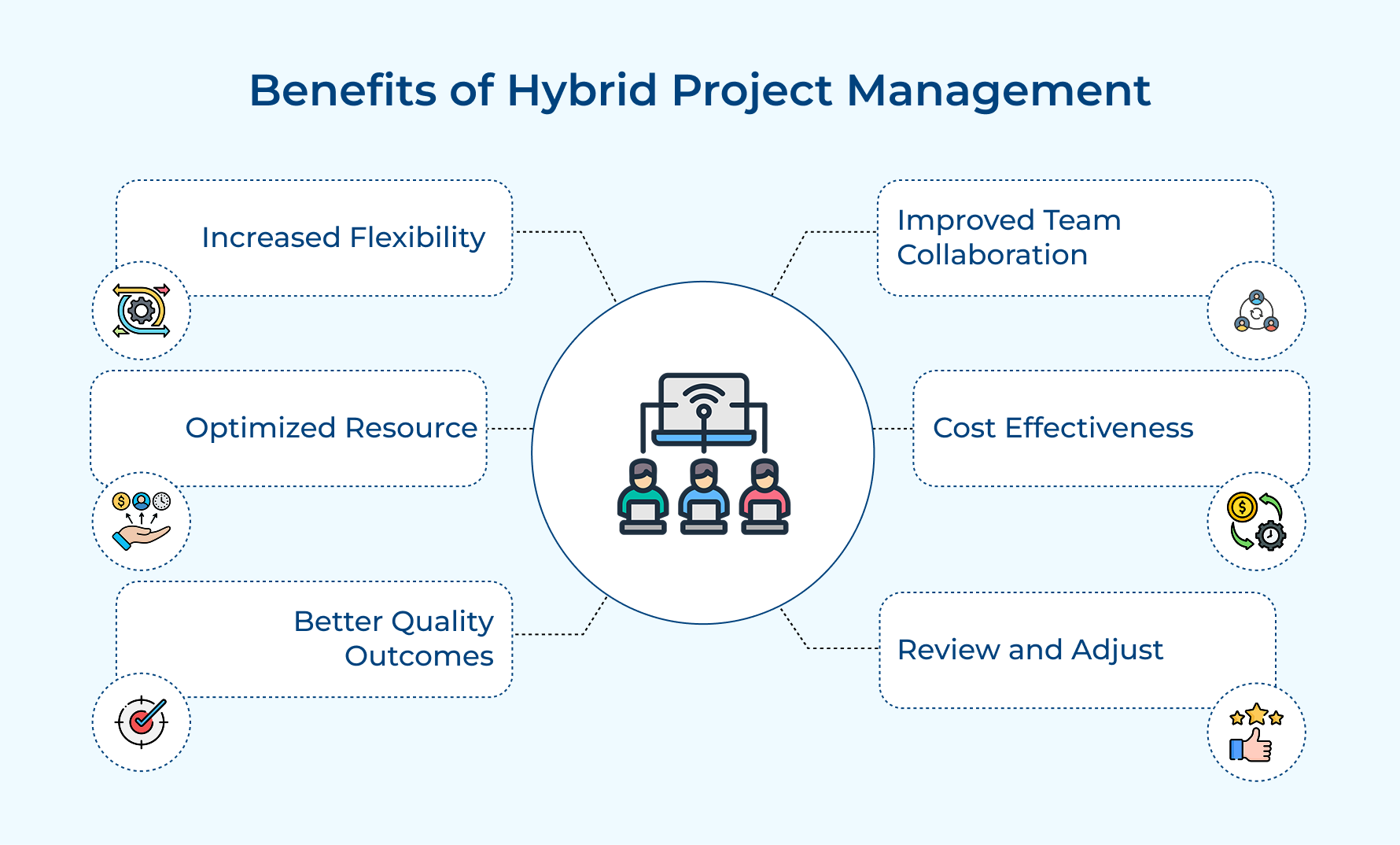Hybrid Project Management: Steps to Implement & Benefits
- What is Hybrid Project Management?
- When to Use a Hybrid Project Management Approach?
- Steps to Implement Hybrid Project Management
- What are The Benefits of Hybrid Project Management?
- Types of Project Management
- What are the Challenges of Hybrid Project Management?
- Unlocking Potential: The Impact of Hybrid Project Management
- FAQs about Hybrid Project Management

Key Highlights:
- Hybrid project management is perfect for projects with diverse deliverables needing both structured planning and agile adaptability.
- Test on smaller segments to identify challenges and refine the approach.
- HPM allows seamless switching between methodologies to meet changing project needs.
Are you struggling to find the right balance between flexibility and structure in your projects? It is not uncommon to see how many teams face this challenge as they navigate evolving requirements and stakeholder demands.
Hybrid project management offers a solution by combining the best elements of traditional and Agile methodologies. Teams here get to adapt swiftly while maintaining clarity and control.
We’ll explore the principles of hybrid project management, its key benefits, and practical steps for successful implementation.
What is Hybrid Project Management?
Hybrid project management is a flexible approach that combines traditional (waterfall) and agile methodologies to leverage the strengths of both frameworks. This methodology allows organizations to adapt their project management style according to specific project needs, team preferences, and business requirements.
The blend forms the foundation of hybrid project management methodologies, offering the best of both structured and adaptive approaches. Understanding the hybrid project management definition helps businesses adopt the right mix of strategies to improve efficiency.
Key objectives:
- Maximize project efficiency by utilizing the most appropriate methodology for each project component or phase.
- Enhance adaptability while maintaining necessary structure and documentation for accountability as well as compliance.
- Improve stakeholder satisfaction by providing regular deliverables while ensuring overall project alignment with strategic goals.
- Reduce project risks by combining detailed planning with iterative development and continuous feedback loops.
When to Use a Hybrid Project Management Approach?
Understanding the right scenarios for a hybrid project management approach enhances project adaptability and effectiveness. Here are key considerations:
Complex Project Requirements
Projects with many layers, technical demands, and interdependent deliverables thrive with hybrid management. It balances structured planning with agile flexibility, making it ideal for diverse project needs.
Diverse Stakeholder Expectations
Different stakeholders often have unique preferences—some want fixed timelines, while others need frequent updates. The hybrid project management process caters to both, ensuring everyone’s on the same page.
Multiple Project Components
When a project has different work streams, hybrid management shines. Teams can use sequential planning for some parts and agile methods for others, tailoring the approach to each component.
Client Integration Needs
For projects needing constant client involvement and structured milestones, hybrid methods work best. Agile keeps clients engaged, while traditional frameworks manage major delivery points.
Regulatory Compliance Needs
Regulated industries benefit from hybrid models. Teams ensure compliance and proper documentation with traditional methods while using agile practices for innovation as well as development.
Transitioning Organizations
Moving from traditional to agile methodologies can be challenging. Hybrid approaches act as a bridge, helping teams adapt gradually while retaining familiar processes.
Long-term Projects with Phased Deliverables
Hybrid management is perfect for long projects. Teams plan strategically with traditional methods and deliver incrementally through agile, ensuring steady progress as well as tangible outcomes.
Steps to Implement Hybrid Project Management
To implement hybrid project management, careful planning and execution are essential. Here are the essential steps to guide your process.
1. Assess Project Requirements
Understanding your project’s unique needs, complexities, and stakeholder expectations is the key to setting a solid foundation. Getting this right early helps align everyone’s efforts, avoid missteps, and keep scope creep in check.
Start by chatting with stakeholders—hold interviews, run workshops, or send out surveys to get their perspectives. Dive into the project’s scope, constraints, and goals to identify the must-haves. These insights will steer your choice of methodologies and keep the project on track.
Actionable Tips:
- Draft a detailed requirements document that captures everything from stakeholder feedback to key features and goals. This will be your go-to reference throughout the project.
- Use a prioritization matrix to rank what’s most urgent and important, so your team focuses on delivering maximum value where it counts.
2. Select Appropriate Methodologies
Choosing the right methods in hybrid project management ensures effective leverage of both structured and agile approaches. A well-thought-out selection minimizes risks associated with your project delivery and maximizes team effectiveness.
Evaluate methodologies like Waterfall for phases requiring detailed planning and Agile for execution phases that benefit from adaptability as well as iterative feedback. Map the strengths of each methodology to specific project phases for seamless integration.
For example: A marketing project may benefit from Agile methodologies for rapid iteration, while a construction project might require a Waterfall approach for clear milestones. Create a comparison chart highlighting the strengths and weaknesses of potential methodologies, facilitating informed discussions among team members.
3. Design Project Structure
A clear project structure isn’t just about organization—it’s the foundation for seamless collaboration and efficient execution.
What steps to follow? Here’s the list:
Integrating Methodologies:
- Create a framework that blends chosen methodologies effectively.
- Clearly define how tasks will be executed to streamline workflows.
Defining Roles and Responsibilities:
- Outline team roles to ensure everyone knows their responsibilities.
- Build accountability by aligning tasks with individual strengths.
Visualizing Project Flow:
- Use tools like Gantt charts or Kanban boards to map out phases, deliverables, and dependencies.
- Simplify understanding of the project flow for all team members.
Use visual project management tools to track progress, spot bottlenecks, and address issues promptly.
4. Set Up Project Tools
Effective tools enhance collaboration, communication, and tracking across blended methodologies. Streamlined processes and clear visibility into project status ensure that everyone stays informed as well as aligned with project goals.
Select project management software that supports both Agile and traditional methodologies, such as Trello, Asana, or Jira. Configure tools to reflect the project structure and methodologies, ensuring all team members have access to the same information.
Actionable Tips:
- Integrate tools that facilitate real-time updates and communication, like Slack or Microsoft Teams, to ensure team members can easily share information and feedback.
- Customize dashboards to track key metrics relevant to both methodologies, allowing for better visibility into progress and potential issues.
5. Train Team Members
Effective training equips your team with the skills to confidently navigate a hybrid project approach. It’s not just about learning—it’s about empowering team members to collaborate better and drive project success.
How to Train Your Team:
1. Host Interactive Workshops:
- Conduct sessions to explain both methodologies and their integration.
- Use hands-on exercises, case studies, and role-playing to make learning practical as well as engaging.
2. Create Clear Training Materials:
- Develop guides that break down key concepts and processes.
- Ensure materials are accessible and easy to follow for all team members.
3. Promote Knowledge Sharing:
- Encourage team members to share experiences and insights during training.
- Create a culture of continuous learning and collaboration.
Future Trends: As the demand for hybrid project management grows, more organizations may adopt e-learning platforms for training, allowing for flexible, on-demand education.
6. Launch Pilot Phase
A pilot phase allows teams to test the hybrid approach on a smaller scale, identifying potential issues before full-scale implementation.
Reducing risk and building confidence in the new methodology provide valuable insights for adjustments.
Select a smaller project or segment to pilot the blended approach. Closely monitor performance, and gather feedback from team members, while documenting lessons learned to refine processes and tools for broader application.
7. Monitor Progress and Adapt
Continuous monitoring ensures your project stays on track with its objectives while maintaining flexibility to adapt to changes. This agility is essential in a hybrid approach, helping teams overcome challenges and maintain project momentum for successful outcomes.
Leverage performance metrics, schedule regular check-ins, and gather stakeholder feedback to evaluate progress. Be open to refining processes, timelines, or methodologies as needed, building a culture of responsiveness and improvement.
Establish KPIs that align with both methodologies as well as encourage team discussions to address challenges, celebrate milestones, and collaboratively brainstorm solutions.
8. Conduct Retrospectives
Retrospectives offer a chance for teams to reflect, analyzing what went well and what could improve. The feedback loop helps refine strategies and enhance future project outcomes.
Hold regular retrospective meetings after each project phase to gather insights. Create a supportive space where team members can openly discuss successes, challenges, and suggestions for improvement, ensuring everyone feels heard.
Use structured approaches like “Start, Stop, Continue” to focus discussions on actionable takeaways. Document findings and share them with stakeholders to promote accountability while building a repository of valuable lessons.
What are The Benefits of Hybrid Project Management?
The advantages of hybrid project management offer unique benefits that improve project outcomes. Here are the significant benefits teams can expect:
Increased flexibility: Hybrid project management allows teams to adapt their approach based on specific project needs and changing circumstances. Teams can switch between agile and traditional methods as required, making it easier to respond to market changes, stakeholder requests, as well as evolving project requirements.
Optimized resource: Use Organizations allocate resources more efficiently through combined methodologies in hybrid management. Teams apply traditional planning for predictable tasks while implementing agile methods for complex work, ensuring optimal utilization of each resource in the most effective way possible.
Better quality outcomes: Continuous quality checks emerge through agile iterations while maintaining structured quality control from traditional methods. Regular monitoring helps identify and resolve issues early, leading to higher-quality deliverables that meet stakeholder expectations.
Improved team collaboration: Structured communication channels blend with Agile’s emphasis on frequent interaction in hybrid approaches. Clear role definitions and effective cross-functional cooperation create enhanced team dynamics, resulting in improved project outcomes.
Cost effectiveness: Hybrid management merges detailed budgeting from traditional methods with Agile’s iterative approach to value delivery. Organizations maintain budget oversight while making quick adjustments to prevent cost overruns and maximize return on investment.
Enhanced risk management: Comprehensive risk assessment combines traditional planning strategies with Agile’s adaptive response capabilities. Projects benefit from early risk identification and effective mitigation strategies throughout the entire lifecycle, creating a more secure project environment.
Types of Project Management
Familiarity with various project management methodologies is crucial for success. Here are the key types to consider for your projects.
Waterfall Project Management
Waterfall is a traditional project management methodology that follows a linear and sequential process. Each phase—such as requirements gathering, design, implementation, testing, and maintenance—must be completed before moving on to the next. The approach is highly structured, making it easy to manage and understand.
- Best For: projects with clear, fixed requirements and little expected change, such as construction projects or manufacturing processes. It works well in industries where thorough documentation and defined phases are critical for success.
- Advantages: Clarity in project scope, ease of use, and straightforward progress tracking.
Agile Project Management
Agile project management emphasizes flexibility and adaptability. Work is divided into small, manageable increments known as sprints, typically lasting two to four weeks. Agile encourages constant feedback from stakeholders and promotes collaborative team dynamics.
- Suitable For: software development and projects in fast-paced environments, where requirements are likely to change. Agile enables teams to respond quickly to user feedback and market shifts.
- Advantages: Enhanced customer satisfaction, improved team collaboration, and the ability to pivot quickly in response to changes.
Hybrid Project Management
Hybrid project management combines elements of both traditional and Agile methodologies to create a customized approach that meets the specific needs of a project. It allows teams to leverage the predictability of traditional methods alongside the flexibility of Agile practices.
- Appropriate For: projects with mixed requirements, such as those involving both predictable and unpredictable elements. It is suitable for organizations that need to adapt to changing market conditions while maintaining structure.
- Advantages: Flexibility to respond to changes, better stakeholder engagement, and the ability to apply the most suitable practices for different project phases.
Scrum
Scrum is a specific framework within Agile that organizes work into fixed-length sprints. It includes roles such as Scrum Master, who facilitates the process, and Product Owner, who manages the backlog of tasks. Daily stand-up meetings ensure ongoing communication and quick resolution of issues.
- Well-suited For: complex projects where requirements may evolve, especially in software development. Scrum is ideal for teams looking for a structured yet flexible approach.
- Advantages: Strong focus on teamwork as well as accountability, frequent delivery of functional components, and improved risk management.
Kanban
Kanban is a visual workflow management method that uses boards to visualize tasks and progress. It emphasizes continuous delivery and limits work in progress to improve efficiency. The goal is to identify bottlenecks and optimize flow.
- Particularly Suited For: ongoing projects and teams requiring flexibility, such as marketing teams or service-oriented industries. Kanban is also effective in environments where work needs to be prioritized dynamically.
- Advantages: Increased transparency, better resource management, and enhanced team collaboration.
PRINCE2 (Projects in Controlled Environments)
PRINCE2 is a structured project management methodology that emphasizes organization, control, and quality throughout the project lifecycle. It divides projects into manageable stages, each with defined roles and responsibilities.
- Works Well For: large-scale projects in various sectors, particularly in government and public organizations where a rigorous approach is needed.
- Advantages: Clear framework as well as governance, strong focus on business justification, and comprehensive documentation.
Lean Project Management
Lean project management aims to maximize value while minimizing waste. It focuses on efficiency, continuous improvement, and delivering value to customers by streamlining processes.
- Effective For: manufacturing and production processes, Lean principles can also be applied in service industries aiming for operational excellence as well as cost reduction.
- Advantages: Improved efficiency, reduced costs, and enhanced customer satisfaction through focused value delivery.
What are the Challenges of Hybrid Project Management?
Navigating hybrid project management comes with its challenges. Here are the common obstacles teams may encounter during implementation.
Methodology Integration Conflicts
Blending traditional as well as agile methods can feel like mixing oil and water. Some team members may gravitate toward one approach, causing confusion and inconsistency.
To resolve this, set clear guidelines for when to use each methodology, provide training to explain how they complement each other, and establish a structured integration framework. Regular team workshops can address resistance and create a shared understanding.
Timeline and Budget Alignment
Merging fixed traditional timelines with Agile’s flexible iterations can be tricky. While traditional elements require detailed planning, agile components thrive on adaptability.
Navigate through this by adopting hybrid schedules that balance both needs and add buffer periods between milestones, while implementing flexible budgeting systems to manage both fixed as well as variable costs.
Performance Measurement Issues
Tracking progress gets complicated when different methods use different metrics. Traditional metrics might miss agile’s nuances, and agile metrics may lack the big-picture view.
The fix? Develop integrated frameworks that combine both, use balanced scorecards to monitor overall progress, and conduct regular reviews to ensure alignment.
Communication Gaps
When teams use different methodologies, silos can form. Traditional teams might lean on formal documentation, while agile teams favor informal chats.
Bridge these gaps with unified communication protocols, collaborative tools, and regular cross-team meetings to keep everyone on the same page.
Complexity in Planning
Planning becomes a puzzle with hybrid approaches, requiring coordination between fixed and flexible elements.
Simplify this by creating detailed plans that map out dependencies, using adaptable planning frameworks, and keeping thorough documentation to ensure all components work cohesively.
Unlocking Potential: The Impact of Hybrid Project Management
Hybrid project management significantly impacts businesses by offering the flexibility to adapt to changing environments while maintaining the structure needed for efficiency. Organizations should consider this approach when faced with complex projects that require both stability and responsiveness.
Integrating traditional and Agile methodologies enables teams to effectively manage risks, enhance collaboration, as well as deliver better results. Such adaptability allows businesses to respond quickly to stakeholder feedback and market demands.
Implementing hybrid project management can transform project outcomes, positioning your organization to thrive in a competitive market. Embracing this methodology represents a strategic move toward sustained success and innovation.
Limit time — not creativity
Everything you need for customer support, marketing & sales.
Neeti Singh is a passionate content writer at Kooper, where he transforms complex concepts into clear, engaging and actionable content. With a keen eye for detail and a love for technology, Tushar Joshi crafts blog posts, guides and articles that help readers navigate the fast-evolving world of software solutions.



